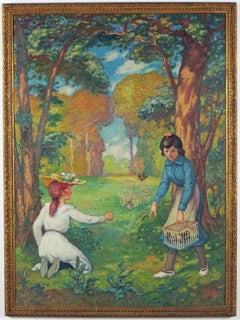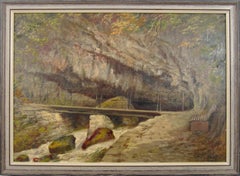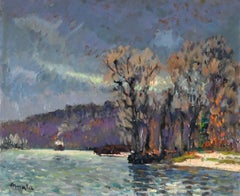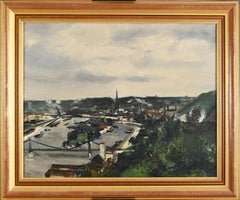
Two Young Girls in a Flowering Field
View Similar Items
Want more images or videos?
Request additional images or videos from the seller
1 of 8
Dianne Elizabeth FlynnTwo Young Girls in a Flowering Field1980's
1980's
About the Item
- Creator:Dianne Elizabeth Flynn (1939, English)
- Creation Year:1980's
- Dimensions:Height: 28.75 in (73.03 cm)Width: 24.75 in (62.87 cm)Depth: 2 in (5.08 cm)
- Medium:
- Movement & Style:
- Period:
- Condition:
- Gallery Location:Sheffield, MA
- Reference Number:Seller: Art F4511stDibs: LU70032380261
About the Seller
3.7
Vetted Seller
These experienced sellers undergo a comprehensive evaluation by our team of in-house experts.
1stDibs seller since 2017
46 sales on 1stDibs
More From This SellerView All
- Les VendangesBy Georges d'EspagnatLocated in Sheffield, MAGeorges d'Espagnat French, 1870 - 1950 Les Vendanges Signed gdE (lower left) Oil on canvas 67 by 43 in. W/frame 71 by 47 in. Born at Melun on 14th August 1870, Georges d’Espagnat...Category
1910s Post-Impressionist Figurative Paintings
MaterialsOil
- Le Piège à OiseauxBy Georges d'EspagnatLocated in Sheffield, MAGeorges D'espagnat French, 1870 - 1950 Le Piège à Oiseaux Signed gdE (lower right) Oil on canvas 66 3/4 by 48 1/2 in. W/frame 70 ¾ by 52 ½ in. Born at Melun on 14th August 1870, G...Category
1910s Post-Impressionist Figurative Paintings
MaterialsOil
- BathersBy John Edward CostiganLocated in Sheffield, MAJohn Edward Costigan, N.A. American, 1888-1972 Bathers Oil on canvas Signed ‘J.E. Costigan N.A.’ lower left 20 by 24 in. W/frame 26 by 30 in. John Costigan was born of Irish-American parents in Providence, Rhode Island, February 29, 1888. He was a cousin of the noted American showman, George M. Cohan, whose parents brought the young Costigan to New York City and was instrumental in starting him on a career in the visual arts. They were less successful in encouraging him to pursue formal studies at the Art Students League (where, however, he later taught) than in exposing him to the commercial art world through the job they had gotten him with the New York lithographing firm that made their theatrical posters. At the H. C. Miner Lithographing Company, Costigan worked his way up from his entry job as a pressroom helper, through various apprenticeships, to the position of sketch artist. In the latter capacity he was an uncredited designer of posters for the Ziegfeld Follies and for numerous silent films. Meanwhile, he had supplemented his very meager formal studies in the fine arts with a self-teaching discipline that led to his first professional recognition in 1920 with the receipt of prizes for an oil painting and watercolor in separate New York exhibitions. A year earlier, Costigan had wed professional model Ida Blessin, with whom he established residence and began raising a family in the sleepy little rural New York hamlet of Orangeburg, the setting for the many idyllic farm landscapes and wood interiors with which he was to become identified in a career that would span half a century. John Costigan’s first national recognition came in 1922 with his winning of the coveted Peterson Purchase prize of the Art Institute of Chicago for an oil on canvas, “Sheep at the Brook.” It marked the start of an unbroken winning streak that would gain him at least one important prize per year for the remainder of the decade. The nation’s art journalists and critics began to take notice, making him the recurring subject of newspaper features and magazine articles. The eminent author and critic Edgar Holger Cahill was just a fledgling reporter when he wrote his first feature, “John Costigan Carries the Flame,” for Shadowland Magazine in 1922. Costigan had his first one-man show of paintings at the Rehn Gallery on New York’s 5th Avenue in November, 1924, to be followed less than three years later by another at the Art Institute of Chicago. In addition, Costigan’s work has been—and continues to be included, side-by-side with that of some of America’s most high-profile artists, in museum and gallery exhibitions throughout the country. His renown had peaked in the early 1930s, by which time his work had been honored with nearly every major award then being bestowed in the fine arts and had been acquired for the permanent collections of several prestigious American museums, including New York’s Metropolitan (which only recently, in 1997, deaccessioned his “Wood Interior,” acquired in 1934). Although Costigan’s celebrity had ebbed by the late 1930s, the Smithsonian Institution saw fit in 1937 to host an exhibition exclusively of his etchings. And, in 1941, the Corcoran Gallery (also Washington, D.C.) similarly honored him for his watercolors. (Another Washington institution, the Library of Congress, today includes 22 Costigan etchings and lithographs in its permanent print collection.) During World War II, Costigan returned briefly to illustrating, mainly for Bluebook, a men’s pulp adventure magazine. A gradual revival of interest in his more serious work began at the end of the war, culminating in 1968 with the mounting of a 50-year Costigan retrospective at the Paine Art Center and Arboretum in Oshkosh, Wisconsin. Oils, watercolors and prints were borrowed from museums and private collections throughout the country, and the exhibition was subsequently toured nationally by the Smithsonian Institution. John Costigan died of pneumonia in Nyack, NY, August 5, 1972, just months after receiving his final prestigious award —the Benjamin West Clinedinst Medal of the Artist’s Fellowship, Inc., presented in general recognition of his “...achievement of exceptional artistic merit...” in the various media he had mastered in the course of his career. This painting depicts one of the artist's favorite themes --the farm family bathing...Category
1950s Post-Impressionist Figurative Paintings
MaterialsOil
- Woman and ChildBy John Edward CostiganLocated in Sheffield, MAJohn Edward Costigan, N.A. American, 1888-1972 Woman and Child Oil on canvas Signed ‘J.E. Costigan N.A.’ lower left 24 by 30 in. W/frame 32 by 38 in. John Costigan was born of Irish-American parents in Providence, Rhode Island, February 29, 1888. He was a cousin of the noted American showman, George M. Cohan, whose parents brought the young Costigan to New York City and was instrumental in starting him on a career in the visual arts. They were less successful in encouraging him to pursue formal studies at the Art Students League (where, however, he later taught) than in exposing him to the commercial art world through the job they had gotten him with the New York lithographing firm that made their theatrical posters. At the H. C. Miner Lithographing Company, Costigan worked his way up from his entry job as a pressroom helper, through various apprenticeships, to the position of sketch artist. In the latter capacity he was an uncredited designer of posters for the Ziegfeld Follies and for numerous silent films. Meanwhile, he had supplemented his very meager formal studies in the fine arts with a self-teaching discipline that led to his first professional recognition in 1920 with the receipt of prizes for an oil painting and watercolor in separate New York exhibitions. A year earlier, Costigan had wed professional model Ida Blessin, with whom he established residence and began raising a family in the sleepy little rural New York hamlet of Orangeburg, the setting for the many idyllic farm landscapes and wood interiors with which he was to become identified in a career that would span half a century. John Costigan’s first national recognition came in 1922 with his winning of the coveted Peterson Purchase prize of the Art Institute of Chicago for an oil on canvas, “Sheep at the Brook.” It marked the start of an unbroken winning streak that would gain him at least one important prize per year for the remainder of the decade. The nation’s art journalists and critics began to take notice, making him the recurring subject of newspaper features and magazine articles. The eminent author and critic Edgar Holger Cahill was just a fledgling reporter when he wrote his first feature, “John Costigan Carries the Flame,” for Shadowland Magazine in 1922. Costigan had his first one-man show of paintings at the Rehn Gallery on New York’s 5th Avenue in November, 1924, to be followed less than three years later by another at the Art Institute of Chicago. In addition, Costigan’s work has been—and continues to be included, side-by-side with that of some of America’s most high-profile artists, in museum and gallery exhibitions throughout the country. His renown had peaked in the early 1930s, by which time his work had been honored with nearly every major award then being bestowed in the fine arts and had been acquired for the permanent collections of several prestigious American museums, including New York’s Metropolitan (which only recently, in 1997, deaccessioned his “Wood Interior,” acquired in 1934). Although Costigan’s celebrity had ebbed by the late 1930s, the Smithsonian Institution saw fit in 1937 to host an exhibition exclusively of his etchings. And, in 1941, the Corcoran Gallery (also Washington, D.C.) similarly honored him for his watercolors. (Another Washington institution, the Library of Congress, today includes 22 Costigan etchings and lithographs in its permanent print collection.) During World War II, Costigan returned briefly to illustrating, mainly for Bluebook, a men’s pulp adventure magazine. A gradual revival of interest in his more serious work began at the end of the war, culminating in 1968 with the mounting of a 50-year Costigan retrospective at the Paine Art Center and Arboretum in Oshkosh, Wisconsin. Oils, watercolors and prints were borrowed from museums and private collections throughout the country, and the exhibition was subsequently toured nationally by the Smithsonian Institution. John Costigan died of pneumonia in Nyack, NY, August 5, 1972, just months after receiving his final prestigious award —the Benjamin West Clinedinst Medal of the Artist’s Fellowship, Inc., presented in general recognition of his “...achievement of exceptional artistic merit...” in the various media he had mastered in the course of his career. This painting depicts one of the artist's favorite themes --the farm family bathing...Category
1940s Post-Impressionist Landscape Paintings
MaterialsOil
- Djeuner ChamptreBy Marcel DyfLocated in Sheffield, MAMarcel Dyf French, 1899-1985 Djeuner Champtre Oil on canvas 23 ½ by 28 ¾ in. W/frame 31 ½ by 36 ¾ in. Signed lower left Marcel Dyf (Marcel Dreyfus) was born in Paris on October 7,...Category
1950s Post-Impressionist Figurative Paintings
MaterialsOil
- Woman in KimonoBy Everett Lloyd BryantLocated in Sheffield, MAEverett Lloyd Bryant American, 1864-1945 Woman in Kimono Oil on canvas Signed lower right 30 by 25 in. W/frame 35 by 30 in. Everett studied wit...Category
1920s Post-Impressionist Figurative Paintings
MaterialsOil
You May Also Like
- Rudolf Johann Weiss ( 1846 – 1933 ) Twannbach Cave Oil Painting Switzerland 1926By Rudolf Johann WeissLocated in Meinisberg, CHRudolf Johann Weiss (Swiss, * 3.9.1846 Basel, † 17.4.1933 Biel) Die Twannbachgrotte/Twannbachschlucht bei Twann, Biel, Schweiz (= The Twannbach Cave/Twannbach Canyon by Douanne, Bie...Category
1920s Post-Impressionist Landscape Paintings
MaterialsOil, Board
- La Seine en amont de RouenLocated in LE HAVRE, FRAlbert MALET (1905-1986) La Seine en amont de Rouen Oil on panel (isorel) Size: 38 x 46 cm Signed lower left In very good state of conservation. Recently cleaned and varnished. Be...Category
1960s Post-Impressionist Figurative Paintings
MaterialsOil, Panel
- Vue de RouenBy Gaston SebireLocated in LE HAVRE, FRGaston Sebire (1920-2001) Vue de Rouen Oil on canvas Size : 65 x 81 cm Signed lower right Provenance : Private Collection, France Very good condition. Original canvas. Frame included...Category
1960s Post-Impressionist Landscape Paintings
MaterialsCanvas, Oil
- Haystack with Resting FiguresBy John Maclauchlan MilneLocated in Hillsborough, NCScottish artist John Maclauchlan Milne, RSA, (1885-1957) is a contemporary of Scottish Colourists Peploe, Fergusson, Cadell and Hunter. Like the...Category
1920s Post-Impressionist Landscape Paintings
MaterialsCanvas, Oil
- Original oil-Autumn in London IV-expression-landscape-plein air-UK awarded ArtisLocated in London, GBThis is one of the most personal paintings of Shizico Yi. The painting is fully insured when shipping to worldwide. We offer the original artwork with Artist’s lifetime Warranty. To...Category
2010s Post-Impressionist Landscape Paintings
MaterialsOil, Gesso, Acrylic, Stretcher Bars
$3,472 Sale Price20% OffFree Shipping - Spanish fishermen on the beach Spain oil on board paintingBy Gabriel CasarrubiosLocated in Barcelona, BarcelonaGabriel Casarrubios Martín (1953) - Fishermen - Oil on panel Oil size 27x22 cm. Frameless. Gabriel Casarrubios Martín (1953) The Toledo artist trained in Fine Arts in Madrid, at th...Category
21st Century and Contemporary Post-Impressionist Landscape Paintings
MaterialsOil, Board
$483 Sale Price26% Off
Recently Viewed
View AllMore Ways To Browse
Chester Fields
A Polak
Elizabeth Cooper
Le Vintage Honfleur
W B Thompson
Baron Gerard
Dianne B
Fun Pop Art
Miniature Oil Painting
Gray Scale Art Figurative
Van S Painting
Blue Portrait Contemporary Figurative
Original Fashion Illustration
Large Cafe
Nature Surreal
Woman In White Dress
Beaux Arts Architecture
Wedding In Paintings









